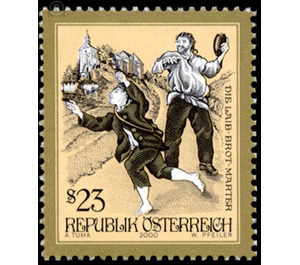Myths and legends - Austria / II. Republic of Austria 2000 - 23 Shilling
Theme: Architecture
| Country | Austria / II. Republic of Austria |
| Issue Date | 2000 |
| Face Value | 23.00 |
| Printing Type | combination printing |
| Stamp Type | Definitive |
| Item Type | Stamp |
| Chronological Issue Number | 1667 |
| Chronological Chapter | OOS-OE2 |
| SID | 477762 |
| In 64 Wishlists | |
The motif of the brand is located on the road from Oberndorf to Oberpfaffendorf on a hill at the outskirts of Raabs an der Thaya in the district of Waidhofen an der Thaya in Lower Austria. Marterl are those corridor monuments that show a representation of the "Passio Christi" (suffering) or the "Arma Christi" (instruments of torture), but also such objects that bring to mind a tragic incident. Thus, the story also commemorates a tragic event that was the reason for the establishment (probably in 1301) of Raabser "loaf-bread-Marter" (= Marterl) was: In times of great poverty stole a hungry Handwerksbursche of a rich Farmers in Oberndorf a big loaf of bread. The lad was however watched by the farmer. To be able to walk faster, the guy finally threw away the bread on the run. The farmer, however, picked up the bread and hurled it in his anger at the fleeing boy so hard that he fell to the ground. The court finally condemned the farmer to build a torture at this point. According to another tradition, the same torture is said to have been erected in memory of the killing of a craftsman by a baker in whose shop the young man had stolen a loaf of bread. In the vernacular, this hall monument is also called "G'spitzte Marter" or "Black Marter".


